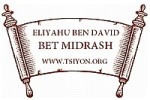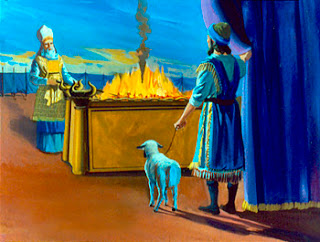Need to talk to us? - In the USA and Canada just call us toll free at (888) 230-2440 for help. Internationally, email us and we will arrange a phone or Skype call for you.
From
Eliyahu
Have you ever had that feeling that you did something wrong, but you don't know what it was? That can be a very nagging feeling to have. Even worse is embarrassment you feel when you realize that you may have inadvertently said or did the wrong thing and possibly offended someone, maybe even Elohim. Have you ever wondered how YHWH wants us to handle such inadvertent unintentional sins? Since we didn't know or didn't mean it can't we just forget it, and move on past it? If not, why not? Questions like these are answered for us in the Book of Leviticus. In fact, Leviticus excels at defining right and wrong as YHWH sees it, as well us giving us a clear path to make things right with Him and with others whom we may have offended. This sort of information was and is vital for Yah's nation to get along with one another and with Him. Leviticus helps to get everyone on the same page - His page! In our latest Midrash we look at Leviticus 4+5 as we learn more about unintentional sin than we you have ever thought there is to know. Join us as for this valuable adventure in Leviticus, on Tsiyon Road, this Sabbath.
Blessings and Shalom!
Eliyahu ben David
www.tsiyon.org
PS - More and more is being discovered from King David's kingdom. Below is a newspaper article from just last week reporting the latest find.
________________________________________________________
Daniel Estrin
Jerusalem: An
Israeli archaeologist says he has found the legendary citadel captured by King
David in his conquest of Jerusalem, rekindling a longstanding debate about using
the Bible as a field guide to identifying ancient ruins.
Mr
Shukron, who excavated at the City of David archaeological site for nearly two
decades, says he believes strong evidence supports his theory.
Photo: AP
"This is the citadel of King David, this is the
Citadel of Zion, and this is what King David took from the Jebusites," said Mr
Shukron, who said he recently left Israel's Antiquities Authority to work as a
lecturer and tour guide. "The whole site we can compare to the Bible perfectly."
Most archaeologists in Israel do not dispute that
King David was a historical figure, and a written reference to the "House of
David" was found in an archaeological site in northern Israel. But
archaeologists are divided on identifying Davidic sites in Jerusalem, which he
is said to have made his capital.
Mr Shukron's dig, which began in 1995, uncovered
a massive fortification of five-ton stones stacked 6 meters wide. Pottery shards
helped date the fortification walls to be 3800 years old. They are the largest
walls found in the region from before the time of King Herod, the ambitious
builder who expanded the Second Jewish Temple complex in Jerusalem almost 2100
years ago. The fortification surrounded a water spring and is thought to have
protected the ancient city's water source.
The fortification was built 800 years before King
David would have captured it from its Jebusite rulers. Mr Shukron says the
biblical story of David's conquest of Jerusalem provides clues that point to
this particular fortification as David's entry point into the city.
In the second Book of Samuel, David orders the
capture of the walled city by entering it through the water shaft. Mr Shukron's
excavation uncovered a narrow shaft where spring water flowed into a carved
pool, thought to be where city inhabitants would gather to draw water. Excess
water would have flowed out of the walled city through another section of the
shaft Mr Shukron said he discovered where he believes the city was penetrated.
Mr Shukron says no other structure in the area of
ancient Jerusalem matches what David would have captured to take the city. The
biblical account names it the "Citadel of David" and the "Citadel of Zion."
Ronny Reich, who was Mr Shukron's collaborator at
the site until 2008, disagrees with the theory. He said more broken pottery
found from the 10th century BC, presumably King David's reign, should have been
found if the fortification had been in use then.
Mr Shukron said he only found two shards that
date close to that time. He believes the reason he didn't find more is because
the site was in continuous use and old pottery would have been cleared out by
David's successors. Much larger quantities of shards found at the site date to
about 100 years after King David's reign.
Mr Reich said it was not possible to reach
definitive conclusions about biblical connections without more direct
archaeological evidence.
"The connection between archaeology and the Bible
has become very, very problematic in recent years," Mr Reich said.
Critics say that some archaeologists are too
eager to hold a spade in one hand and a Bible in the other in a quest to verify
the biblical narrative either due to religious beliefs or to prove the Jewish
people's historic ties to the land. But other respected Israeli archaeologists
say recent finds match the biblical account more than naysayers claim.
Mr Shukron, a veteran archaeologist who has
excavated a number of significant sites in Jerusalem, said he drew his
conclusions after nearly two decades exploring the ancient city.
"I know every little thing in the City of David.
I didn't see in any other place such a huge fortification as this," said Mr
Shukron.
The biblical connection to the site is emphasized
at the City of David archaeological park, where the "Spring Citadel" the
excavation's official name has been retrofitted for tourists, including a
movie projected on a screen in front of the fortification to illustrate how it
may have looked 3800 years ago. The City of David located in east Jerusalem
is one of the most popular tourist sites in the holy city, with 500,000 tourists
visiting last year.
"We open the Bible and we see how the archaeology
and the Bible actually come together in this place," said Doron Spielman, vice
president of the nonprofit Elad Foundation, which oversees the archaeological
park. He carried a softcover Bible in his hand as he ambled around the
excavation.
Original of this abridged story
was found at: http://www.smh.com.au/world/king-davids-citadel-discovered-as-politics-and-archaeology-collide-in-jerusalem-20140507-zr5yd.html
King David's citadel 'discovered' in
Jerusalem
Published: May 7, 2014 - 6:06AM  The
claim joins a string of announcements by Israeli archaeologists saying they have
unearthed palaces of the legendary biblical king, who is revered in Jewish
religious tradition for establishing Jerusalem as its central holy city but
who has long eluded historians looking for clear-cut evidence of his existence
and reign.
The
claim joins a string of announcements by Israeli archaeologists saying they have
unearthed palaces of the legendary biblical king, who is revered in Jewish
religious tradition for establishing Jerusalem as its central holy city but
who has long eluded historians looking for clear-cut evidence of his existence
and reign.
________________________________________________________








